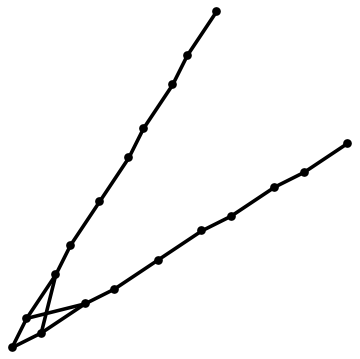The Wythoff’s Game Evolution Graph
In my paper Nim Fractals written with Joshua Xiong we discovered an interesting graph structure on P-positions of impartial combinatorial games. P-positions are vertices of the graph and two vertices are connected if they are consecutive P-positions in an optimal longest game.
A longest game of Nim is played when exactly one token is removed in each turn. So in Nim two P-positions are connected if it is possible to get from one of them to the other by removing two tokens.
In the paper we discussed the evolution graph of Nim with three piles. The graph has the same structure as three branches of the Ulam-Warburton automaton.

For completeness, I would like to describe the evolution graph of the 2-pile Nim. The P-positions in a 2-pile Nim are pairs (n,n), for any integer n. Two positions (n,n) and (m,m) are connected if and only if m and n differ by 1. The first picture represents this graph.
The Wythoff’s game is more interesting. There are two piles of tokens. In one move a player can take any number of tokens from one pile or the same number of tokens from both piles.
The P-positions (n,m) such that n ≤ m start as: (0,0), (1,2), (3,5), (4,7), (6,10) and so on. They can be enumerated using φ: the golden ratio. Namely, nk = ⌊kφ⌋ and mk = ⌊kφ2⌋ = nk + k, where k ≥ 0.

In a longest Wythoff’s game the difference between the coordinates decreases by 1. That is, it takes a maximum of 2k steps to end an optimal game starting from position (nk,mk). The picture shows the evolution graph.
The interesting part of the picture is the crossover between two “lines”. From positions with large coordinates like (6,10) with a difference of 4 you can get to only one position with a difference of 3: (4,7) and not (7,4). But from position (3,5) with a difference of 2 you can get to both positions with a difference of 1: (1,2) and (2,1).
Share:
Urban:
Hi,
It is interesting to have a new model for graphs om impartial combinatorial games. Most graph representations so describes the kernel of the game graph as the unique set of P-positions. I am not yet familiar with research on hte optimal game graph, but like to learn more. Particularly interesting is the connection to CA. We have a recent discovery of a CA representing the P-positions of Blocking Wythoff Nim: https://arxiv.org/abs/1506.01431
So what else is known regarding Wythoff Nim and consecutive P-positions in an optimal longest game?
There are many variations of Wythoff Nim, for example Holladays $k$ Wythoff nim, but also Maharaja Nim (the Queen can also move like a knight of Chess) and the GDWN family, where new `diagonals’ of rational slopes are adjoined as moves to Wythoff Nim. Each variation has its Evolution graph, and it would be interesting to understand them, but most of these game have non-well-behaved P-positions…
28 October 2015, 8:57 pm